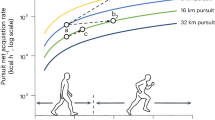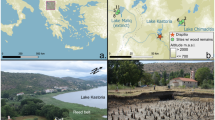Abstract
Models of seasonal mobility to exploit seasonally abundant food sources have been proposed for prehistoric hunter-gatherers in many parts of the world1–3. Some such hypotheses involve fundamental and insufficiently tested assumptions about the nature of both hunter-gatherer societies and the archaeological evidence that they leave. The present study is an independent test of such a hypothesis proposed for the southwestern Cape of South Africa. In this strongly ecologically differentiated area there are four distinct ecological zones that would have offered four different sets of resources to prehistoric people. Obvious modern seasonal fluctuations in these resources, plus a considerable amount of archaeological evidence, led to the suggestion that prehistoric hunter-gatherers moved in a regular seasonal cycle across the zones4,5; this would have allowed them to make maximum use of temporarily plentiful plant and animal foods in some areas, while avoiding lean periods in others. However, as reported here, direct measurements of food intake, as reflected in the stable carbon isotope ratios of archaeological human skeletons, reveal that this was not the case. The implications of this study extend beyond the relevance to local archaeology to more general questioning of the ways in which archaeological data should be used to generate hypotheses.
This is a preview of subscription content, access via your institution
Access options
Subscribe to this journal
Receive 51 print issues and online access
$199.00 per year
only $3.90 per issue
Buy this article
- Purchase on Springer Link
- Instant access to full article PDF
Prices may be subject to local taxes which are calculated during checkout
Similar content being viewed by others
References
Higgs, E. S., Vita-Finzi, C., Harris, D. R. & Fagg, A. E. Proc. prehist. Soc. 33, 1–29 (1967).
Higham, C. in Problems in Economic and Social Archaeology (eds Sieveking, G., Longworth, I. H. & Wilson, K. E.) 221–233 (Duckworth, London, 1976).
Schrire, C. in Models in Archaeology (ed. Clarke, D. L.) 653–670 (Methuen, London, 1972).
Parkington, J. E. Afr. Stud. 31, 223–243 (1972).
Parkington, J. E. in Advances in World Archaeology (eds Wendorf, F. & Close, A.) 89–142 (Academic, London, 1984).
Deacon, H. J. S. Afr. Archaeol. Soc. Goodwin Ser. 1, 26–45 (1972).
Fletemeyer, J. R. S. Afr. archaeol. Bull. 32, 146–149 (1977).
Vogel, J. C. & van der Merwe, N. J. Am. Antiq. 42, 238–242 (1977).
van der Merwe, N. J. Am. Scient. 70, 596–606 (1982).
Sealy, J. thesis, Univ. Cape Town (1984).
Deacon, H. J. S. Afr. archaeol. Soc. Monogr. Ser. 1 (1976).
Thorn, H. B. (ed.) Journal of Jan van Riebeeck Vols 1, 2, 3, (A. A. Balkema, Cape Town, 1952, 1954, 1958).
Author information
Authors and Affiliations
Rights and permissions
About this article
Cite this article
Sealy, J., van der Merwe, N. Isotope assessment of Holocene human diets in the southwestern Cape, South Africa. Nature 315, 138–140 (1985). https://doi.org/10.1038/315138a0
Received:
Accepted:
Issue Date:
DOI: https://doi.org/10.1038/315138a0
This article is cited by
-
What's in a bone? Recent advances in archaeological bone chemistry
Journal of Archaeological Research (1997)
-
Bone chemistry and paleodiet
Journal of Archaeological Method and Theory (1994)
-
Stable carbon isotope ratios in Asian elephant collagen: implications for dietary studies
Oecologia (1992)
-
Bone stable isotope studies in archaeology
Journal of World Prehistory (1992)
-
The archaeology of radiocarbon accelerator dating
Journal of World Prehistory (1987)
Comments
By submitting a comment you agree to abide by our Terms and Community Guidelines. If you find something abusive or that does not comply with our terms or guidelines please flag it as inappropriate.



